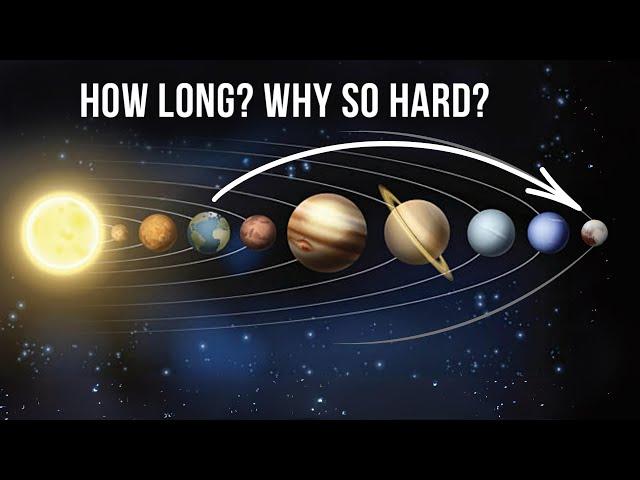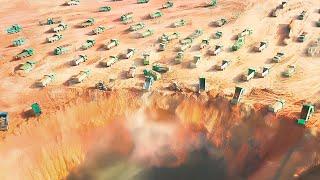
Why Is It So Tough To Go To Pluto? How Long Would It Take Us To Go There?
In our long journey from planet to planet documented in this video series to explain how long it takes to reach each one, we finally arrived at Pluto. Many of us remember from school that Pluto was once considered the ninth planet in the solar system. After 1992, its status was questioned following the discovery of several similarly sized objects in the outermost region of the system called the Kuiper Belt. A fierce debate arose among astronomers, and after the discovery of Eris, which is more massive than Pluto, the International Astronomical Union was forced to formally define the term planet in 2006, effectively excluding Pluto from the list of planets. Did we do the right thing or the wrong thing? We still can't say for sure. What we aim to explain in this video is how long it takes to get there considering all the possible options.
After 9 and a half years of travel and 5 billion kilometers covered, going farther than any other spacecraft has ever gone, in 2015 New Horizons forced us to completely rethink our ideas about a celestial body considered at best a sterile ball of ice. Far from being a dwarf planet, Pluto has a diameter of 2,400 km. It's a large rocky core similar to Earth, wrapped in a mantle of frozen water and perhaps even an underground ocean, itself covered by layers of more volatile ices like nitrogen, methane, and carbon dioxide. All these gases sublimate and then precipitate back onto the surface, freezing and creating an incredibly varied topography with exotic plains, craters, canyons, hills, steep mountains, and perhaps even ice volcanoes. And of course, all this differentiation makes Pluto one of the most colorful worlds in the solar system. So much so, the New Horizon sensors revealed the landscape of stunning vistas. Scientists studying the images believe that the incredible variety of these landscapes comes from eons of interaction between the highly volatile and mobile ices of methane, nitrogen, and carbon monoxide, and the inert water ice, with fascinating cycles of evaporation and condensation cycles even richer than those on Earth, where there's only one material that condenses and evaporates, water. On Pluto, however, there are at least three elements interacting in ways we still don't fully understand across the entire surface.
--
DISCUSSIONS & SOCIAL MEDIA
Commercial Purposes: [email protected]
Tik Tok: https://www.tiktok.com/@insanecuriosity
Reddit: https://www.reddit.com/user/insanecuriosity
Instagram: https://instagram.com/insanecuriositythereal
Twitter: https://twitter.com/insanecurio
Facebook: https://facebook.com/InsaneCuriosity
Linkedin: https://www.linkedin.com/in/insane-curiosity-46b928277/
Our Website: https://insanecuriosity.com/
--
Credits: Ron Miller, Mark A. Garlick / MarkGarlick.com ,Elon Musk/SpaceX/ Flickr
--
00:00 Intro
00:01 Pluto Analysis Facts and composition
5:00 Another element about Pluto Declassification
6:10 How to get to Pluto?
6:50 New Horizons probe
8:10 New Horizons approach Jupiter
9:40 Pluto Position and Orbit
11:54 Futuristic Propulsion (nuclear and antimatter)
12:28 Types of Mission
13:30 Crewed Mission
--
#insanecuriosity #pluto #dwarfplanet
After 9 and a half years of travel and 5 billion kilometers covered, going farther than any other spacecraft has ever gone, in 2015 New Horizons forced us to completely rethink our ideas about a celestial body considered at best a sterile ball of ice. Far from being a dwarf planet, Pluto has a diameter of 2,400 km. It's a large rocky core similar to Earth, wrapped in a mantle of frozen water and perhaps even an underground ocean, itself covered by layers of more volatile ices like nitrogen, methane, and carbon dioxide. All these gases sublimate and then precipitate back onto the surface, freezing and creating an incredibly varied topography with exotic plains, craters, canyons, hills, steep mountains, and perhaps even ice volcanoes. And of course, all this differentiation makes Pluto one of the most colorful worlds in the solar system. So much so, the New Horizon sensors revealed the landscape of stunning vistas. Scientists studying the images believe that the incredible variety of these landscapes comes from eons of interaction between the highly volatile and mobile ices of methane, nitrogen, and carbon monoxide, and the inert water ice, with fascinating cycles of evaporation and condensation cycles even richer than those on Earth, where there's only one material that condenses and evaporates, water. On Pluto, however, there are at least three elements interacting in ways we still don't fully understand across the entire surface.
--
DISCUSSIONS & SOCIAL MEDIA
Commercial Purposes: [email protected]
Tik Tok: https://www.tiktok.com/@insanecuriosity
Reddit: https://www.reddit.com/user/insanecuriosity
Instagram: https://instagram.com/insanecuriositythereal
Twitter: https://twitter.com/insanecurio
Facebook: https://facebook.com/InsaneCuriosity
Linkedin: https://www.linkedin.com/in/insane-curiosity-46b928277/
Our Website: https://insanecuriosity.com/
--
Credits: Ron Miller, Mark A. Garlick / MarkGarlick.com ,Elon Musk/SpaceX/ Flickr
--
00:00 Intro
00:01 Pluto Analysis Facts and composition
5:00 Another element about Pluto Declassification
6:10 How to get to Pluto?
6:50 New Horizons probe
8:10 New Horizons approach Jupiter
9:40 Pluto Position and Orbit
11:54 Futuristic Propulsion (nuclear and antimatter)
12:28 Types of Mission
13:30 Crewed Mission
--
#insanecuriosity #pluto #dwarfplanet
Тэги:
#insane_curiosity #space #science #astronomy #flyby_mission_pluto #pluto #how_long_to_go_to_pluto #how_to_go_to_pluto #new_horizons_mission_pluto #why_is_it_so_tough_to_go_to_pluto #going_to_pluto #journey_to_pluto #from_earth_to_pluto #trip_to_pluto #new_horizons_pluto #pluto_facts #solar_systemКомментарии:
Anomaly screaming #1
s7RanGE
Tom Felton in a suit
Actors_shorts
Упражнения для ягодиц
Vika Odd
WAR HORSE | TOLEDO SHOUT-OUT
Theater League
Trump aungana na Elon Musk kwenye Urushaji wa Jaribio la SpaceX Starship
Simulizi Na Sauti


























